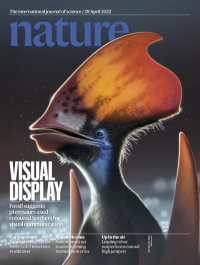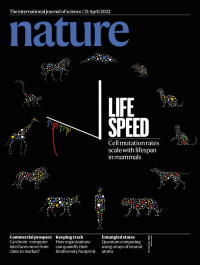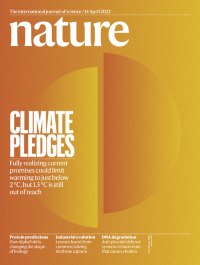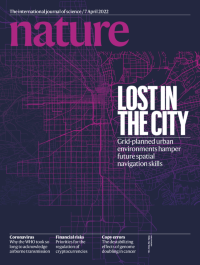Volume 604
-
No. 7907 28 April 2022
Visual displayThe cover shows an artist’s impression of the pterosaur Tupandactylus imperator. Although feathered pterosaurs have been reported, these claims have been controversial and it has not been clear whether these leathery-winged flying reptiles had feathers of different colours like modern-day birds. In this week’s issue, Aude Cincotta and her colleagues present evidence that not only did pterosaurs have feathers but that the feathers probably had varied coloration. The researchers analysed a partial skull of Tupandactylus, found in Brazil and dated to around 113 million years ago. They identified two types of feather along the base of the crest, one of which featured branched structures very similar to modern feathers. They also found pigment-producing organelles in both types of feather and the skin on the head crest. The team suggests that these coloured feathers would have been used in visual communication and that their presence in Tupandactylus indicates the ability to manipulate feather colour stretches back farther than was previously realized.
-
No. 7906 21 April 2022
Life speedCells acquire mutations throughout life, a process that is known to give rise to cancer and has been proposed to contribute to ageing. There is little knowledge, however, about the rate at which mutations accumulate in species other than humans, and whether this rate is influenced by biological traits such as lifespan or body size. In this week’s issue, Alex Cagan, Adrian Baez-Ortega and colleagues address these questions. The researchers studied the speed at which mutations accumulate during life in 16 mammalian species and found that the number of mutations increases by a roughly constant amount each year. They also observed that the molecular processes causing mutations are broadly similar across species. Crucially, the team identified a strong anticorrelation between lifespan and mutation rate: longer-lived species accrue mutations at a slower pace than shorter-lived ones, such that different species have roughly the same number of mutations by the end of their respective lifespans.
-
No. 7905 14 April 2022
Climate pledgesThe Paris climate agreement adopted in December 2015 saw nations around the world commit to limiting global warming to well below 2 °C above pre-industrial levels, and to pursue efforts to limit warming to 1.5 °C. But limited pledges on emissions cuts at the time suggested this goal would be tough to realize. In this week’s issue, Malte Meinshausen and his colleagues analyse the national climate targets put on the table since 2015. The researchers found that if all commitments so far made by nations were to be fully implemented then it would be possible to limit warming to just below 2 °C. They further note that to limit warming to well below 2 °C or 1.5 °C would require a strengthening of pledges for 2030, actions to match these promises and a longer-term target of net-zero CO2 emissions by the middle of the century.
-
No. 7904 7 April 2022
Lost in the cityThe cover image contrasts the grid-like street plan of Chicago with the more chaotic layout of Prague. In this week’s issue, Antoine Coutrot and his colleagues reveal how the environment in which we grow up can affect aspects of our cognition. The researchers used specially designed video games to measure spatial navigation ability in some 397,000 people from 38 countries around the world. They found that people who grew up outside of cities were best at navigation. They also noted that people who grew up in cities such as Chicago with regular, grid-like street plans could navigate environments similar to their home, but were less adept at navigating more chaotic street plans of older cities such as Prague. The researchers suggest that this demonstrates the importance of urban design in human cognition and brain function.
Career Guide




